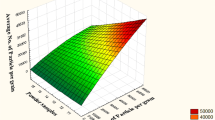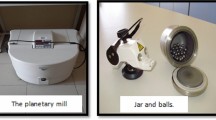Abstract
Thermal shock is one of the most effective techniques in size reduction. The present investigation deals with the effect of thermal shock treatment on grindability and grinding characteristics of sillimanite minerals and also an attempt has been made on the overall energy saving for preparation of sillimanite flour by using ball mill. This attempt is made due to a fine dry grinding of sillimanite minerals to produce sillimanite flour, which is an energy intensive operation. It is observed from the present investigation that the particle sizes at d50 and d80 passing size in microns for thermally treated sillimanite is slightly lower than that of natural sillimanite. The study of grinding kinetics using ball mill indicate that the slope value obtained for thermally treated sillimanite is lower than the natural sillimanite, which shows that the sample responded to higher rate of grinding. The result of grindability studies reveal that the power required for thermal treatment of sillimanite is 395.36 hp and the total energy saving in the order of 8.9 % is achieved by thermal treatment of sillimanite at 900 °C for period of half an hour heating time due to development of numerous micro-cracks and fractures within the mineral grains. Hence, it is recommended to use thermally treated sillimanite for preparation of sillimanite flour (<75 µm particle size) which reduces power consumption of 8.9 %.






Similar content being viewed by others
References
Y. Omer, The effect of heat treatment on colemanite processing: a ceramics application. Powder. Technol. 142, 7–12 (2004)
V. Tamas, N. Lutz, W. Richard, M. Mathias, L. Eugen, H. Tobias, On the breakdown of zircon upon dry thermal annealing. Mineral. Petrol. 97, 129–138 (2009)
S. Routray (2012) Development of process flowsheet to recover total heavy minerals with special reference to zircon from beach sand, dune sand and red sediments of southeastern coast of India, Ph.D Thesis
S. Routray, R. Bhima Rao, Effect of thermal shock on grindability of zircon for preparation of zircon flour. High Temp. Mater. Process. 32(6), 573–579 (2013). doi:10.1515/htmp-2013-0005
T. Laxmi (2014) Beneficiation studies on red sediments of east coast placer deposits of India for industrial applications. Chapter 4, Value addition, PhD thesis, pp. 312–316
R. Swain, R. Bhima Rao, An approach for energy conservation on partially laterised khondalite rocks using thermal shock treatment. Int. J. Mech. Eng. Technol. (IJMET). 5(5), 83–90 (2014)
H.M. Monen Abdel, A.F. Kamel, Thermal treatment for separating quartz from geethitic iron ore of Gebel Ghorabi, Bahariya oasis, Western Desert (and the Middle East), Egypt. J. Afr. Earth. Sci. 17, 89–94 (1993)
R. Rao Bhima, N. Patnaik, Preparation of high pure graphite by alkali digestion method. Scand. J. Metall. 33, 257–260 (2004)
T.J. Veasey, K.E. Fitzgibbon, Thermally assisted liberation of minerals—a review. Miner. Eng. 3, 181–185 (1990)
F.C. Bond (1961), Crushing and grinding calculations. Allis-Chalmers Publication, No. 07R9235B, Revised 2 Jan
Acknowledgments
The authors are thankful to the Director, Institute of Minerals and Materials Technology (CSIR), Bhubaneswar for giving permission to use laboratory facilities.
Author information
Authors and Affiliations
Corresponding author
Rights and permissions
About this article
Cite this article
Laxmi, T., Bhima Rao, R. Effect of Thermal Shock on Grindability of Oleic Adsorbed Flotation Placer Sillimanite. J. Inst. Eng. India Ser. D 96, 21–27 (2015). https://doi.org/10.1007/s40033-014-0055-3
Received:
Accepted:
Published:
Issue Date:
DOI: https://doi.org/10.1007/s40033-014-0055-3




